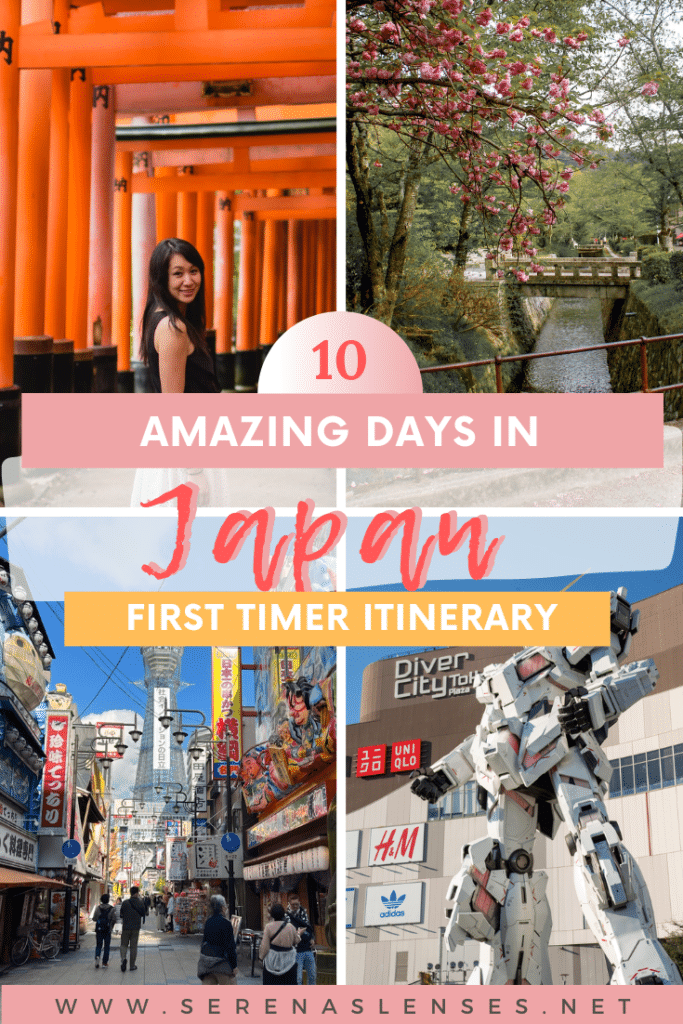Japan 10 Day Itinerary: How to Spend 10 Days in Japan as a First Time Visitor

If you are traveling to Japan for the first time, this complete Japan 10 day itinerary shows you the most essential places to visit in Japan. This Japan itinerary will also show you essential travel information for your 10 days in Japan, such as how to get around, where to stay, what to do and other information.
The land of the rising sun is one of the most popular countries to visit in the world. Known for its rich culture, amazing food, incredible shopping and quirky things to do, Japan is a place you will not regret visiting.
Japan is a place where you will find things cute and innovative, people polite and helpful, trains that are always on time, and a place where everything just goes smoothly. As a traveler, there really is no better travel experience elsewhere than Japan (and that’s why I have been 5 times).
Japan is also one of the safest countries I have ever visited (and one of the best places as a female solo traveler).
If you are a first time traveler to Japan, then this 10 day itinerary for Japan is meant for you! In this first timer Japan itinerary I will include the best cities to visit, things you need to know before visiting Japan, and best places to eat and stay in each city.
Be warned this is a very long post, because I am including very detailed tips and things you need to know before traveling to Japan since I assume this is your first time visit to Japan. All of the tips mentioned in this Japan 10 day itinerary can help make your Japan holiday more smooth and trouble free!
This blog contains occasional affiliate links, where I receive a small commission on sales of the products/hotels that are linked at no additional cost to you. In addition, as an Amazon Associate, I earn from qualifying purchases.

Where to Go in Japan For First Time Visitors?
The most popular cities to visit in Japan for a first timer include Tokyo, Kyoto and Osaka. This is exactly what this itinerary will cover.
Overview of this first-timer 10 day Japan itinerary:
- Day 1: Osaka
- Day 2: Day Trip from Osaka
- Day 3-4: Kyoto
- Day 5: Day Trip from Kyoto
- Day 6 – 10: Tokyo + day trip from Tokyo
This itinerary also assumes you have 10 full days in Japan. If you include travel and flight time during your 10 days in Japan, you will need to modify this itinerary by taking a day off from Tokyo and skip the day trip from Osaka or from Kyoto.
You can also do this 10 day Japan itinerary in reverse order and go to Tokyo first instead of Osaka. But for me I always like to save the best for last because Tokyo really is something that no other cities can rival.
For efficiency purposes, I do NOT suggest flying out from the same city that you originally flew in unless it is a lot cheaper. You can save yourself at least 4-5 hours just by flying out of Tokyo instead of Osaka (and vice versa).
Before we go into the detailed itinerary for Japan, I want to show you some of the most important things you should know about Japan.
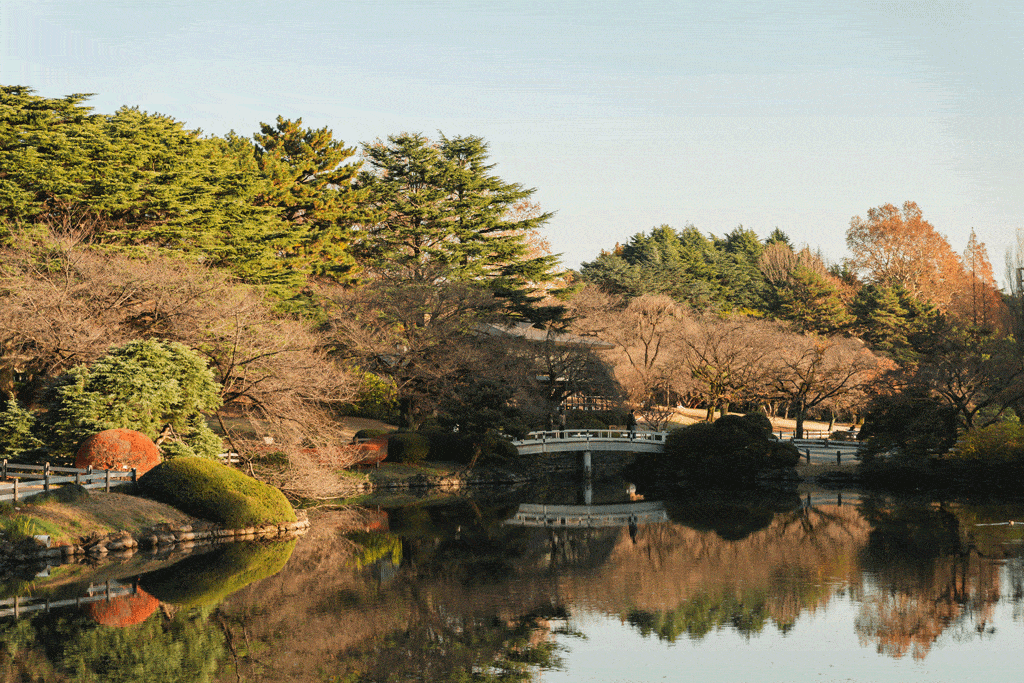
What You Should Know For the First Time in Japan
- The currency in Japan is Japanese Yen. One USD is equivalent to 135-150 Yen.
- The voltage in Japan is 100V (it is 120V in the US and 230V in Central Europe). Therefore you CAN technically use American electronics in Japan without an AC adaptor. But if you are visiting from Europe, you will need an adapter.
- You can drink tap water in Japan.
- Japan is a cash heavy society, many stores and restaurants do not accept credit hard. I suggest you carry at least a hundred dollars of cash with you everyday. Don’t worry, Japan is safe, nobody will steal your cash.
- ATM at 7-Eleven or Lawson are great for taking out cash.
If you are American, I highly recommend getting a Charles Schwab ATM card. They will reimburse you global ATM transaction fees and ATMs generally give you the best exchange rate. Also NEVER accept the offer to have an ATM convert for you, always select to be charged in Yen.
If you are not from the US or do not have a Charles Schwab ATM Card, try to get a Wise Card or Revolut Card instead.
- Download Google Maps to help you find directions and navigate trains in Japan. Also download offline maps on Google Maps in case you do not have internet.
- Download Google Lens so you can translate a photo.
- You should get an IC card when you land in Japan, this card can be preloaded and used to pay for public transportations, vending machines and other things.
You don’t necessarily need a travel pass for Tokyo, an IC card is sufficient!
- The best way to get internet in Japan include getting a physical sim card (you can get this shipped to you), an eSim card (we used this and it worked brilliantly), or rent a pocket wifi to share with your travel companions.
- To expedite your immigration and customs process when arriving in Japan, use the official Visit Japan Web. You will get one 2D codes for immigration clearance and customs declaration. You don’t HAVE to use this, but it is faster.
- Utilize luggage shipping services in Japan, so you don’t have to carry your heavy suitcases around. We used this company but there are others. Your hotel front desk will also be able to help you and answer any questions.
- Prescription Drugs need to be declared before bringing them into Japan. Check the official Ministry of Health website to see what drugs are banned and what procedures are needed to bring medicines into Japan.
- Tipping is not required or expected in Japan. You do not need to tip at restaurants.
Best Time (and Worst Time) to Visit Japan
Spring (mid March to mid April), Fall (mid October to late November) and even December are good time to visit Japan.

Late March – mid April is when Japan’s iconic cherry blossom (sakura) is blooming. The weather in the spring is less humid yet warm but it does get extremely crowded during the cherry blossom season. If you visit just after cherry blossom season finishes, you will see a lot less crowds and that’s what I did once.
Fall (mid October – late November) is also a great time to visit Japan because the weather is starting to cool down and it will be less humid. During the fall months in Japan you can see some of the best foliage and fall colors. In fact fall rivals spring in Japan in terms of popularity and beauty.
If you visit the towns and hotels near Mt. Fuji in October/November you will see the top of Mt. Fuji covered in snow. You won’t see that if you go in September.
Winter in Japan can be a nice time to visit if you want some holiday cheers and don’t mind the cold. There are various Christmas markets in Tokyo in December that are pretty neat to visit.

The worst time to visit Japan is during the summer months and Golden Week. Summer in Japan is very hot and humid, and it is peak typhoon season.
In 2024, Golden Week in Japan is from April 29th to May 5th. During this week you can expect a ton of Japanese domestic tourists traveling around, making it more expensive and crowded to travel.
Where to Stay in Japan for 10 Days
You will find a wide range of accommodations in Japan, including chain hotels, Ryokan (hot spring hotels), Airbnb, monastery (yes you can stay with monks in Japan), and hostels. There are also many unique and interesting accommodation choices in Japan.
As a summary, here are the best hotels for Japan for this itinerary based on our own experience traveling to Japan.
- Osaka: Cross Hotel Osaka in Minami/ Namba
- Kyoto: Cross Hotel Kyoto or Hotel Seiryu
- Tokyo: Keio Plaza Hotel, and Hotel Century Southern Tower
The best hotel booking website for Japan are Agoda, Expedia and Booking.com or you can always book directly with the hotels. I usually check all 4 sources to see which site is cheaper and has better cancellation policy.
First Timer Japan 10 Day Itinerary in Detail
Below is a super detailed itinerary to help show you how to spend 10 days in Japan. Keep in mind that this itinerary assumes you have 10 full days in Japan, and that you are flying into Osaka and out of Tokyo.
You can easily turn this itinerary to a 2 week Japan itinerary if you got a few more days! Since I give you multiple options for day trips, it is easy to just add them onto this 10 day itinerary.
- Day 1: Osaka
- Day 2: Day Trip from Osaka
- Day 3-4: Kyoto
- Day 5: Day Trip from Kyoto
- Day 6 – 10: Tokyo + day trip from Tokyo
Day 0: Arrival into Osaka
Welcome to Japan! You will be flying into Osaka on this day.
After landing in Osaka and going through immigration you will be on your way to your hotel. To get to central Osaka from the airport, you can take trains or a limousine bus.
Note that there are 2 airports in Osaka:
- Kansai International Airport (KIX)
- Osaka International Airport (otherwise known as Itami Airport, with the code ITM.
They each have different airport transportation options, so be sure to check which airport you are flying into.
- Haruka Express (Kansai Airport only) is the fastest train from Kansai Airport to Osaka City Center (Tennoji and Shin-Osaka Station). It requires a JR Pass or the ticket costs 2000-3000 yen (depending on where you get off). You can buy tickets here if you don’t have a JR Pass.
- Kansai-Airport Rapid is another non-JR train that costs 1000-1200 Yen to Tennoji Station or Osaka Station. It’s slower and cheaper than the Haruka Express. You can buy tickets here.
- In addition you can take a Limousine Bus from the airport to Osaka city center.
Where to stay in Osaka: for a first-time visitor, it’s best to stay in the Namba area near Dotonbori. The area is super lively and convenient and you can head straight back to the hotel after drinking and eating.
We stayed at Cross Hotel Osaka both times we visited Osaka and found it super convenient.
Japan Itinerary Day 1: Explore Osaka
Places to visit in Osaka:
- Umeda Sky
- Kuromon Ichiba Market
- Namba Yasaka Jinja
- Shinsekai
- Minami/ Namba
During your first day in Japan and in Osaka you will be exploring the many markets and districts of Osaka. Osaka is known for food and that is what you will be doing today!
Umeda Sky
Opening Time: 9:30am – 10:30pm daily
Ticket Price: 1500 yen for adults; 700 yen for children 4-12; children under 4 are free. Free if you have the Osaka E-Pass between 9:30am – 4pm.

Umeda Sky Building is a very famous landmark building in Osaka. Famous for its distinctive architecture and beautiful panoramic views of the city, Umeda Sky is a popular destination for first-time Osaka visitors.

Umeda Sky Building actually has two 40-story towers that are connected at the top by a circular open-air observatory called Floating Garden Observatory (Kuchu Teien Observatory). The escalator to the observatory is a sight itself with its tube-like tunnel.

There is an area that has love locks where you can put personalized colorful locks. Note that the love locks got so popular you have to buy them online ahead of time now instead of in the store at Umeda Sky.

You will also find a cafe (SKY 40), shop, Chinese restaurant Sangu, and a bar on top of Umeda Sky.
You can spend about an hour at Umeda Sky.
Alternatively, if you do not want to go to Umeda Sky, another popular observatory in Osaka is Harukas 300, the tallest building in Osaka.
Kuromon Ichiba Market [Avoid Visiting on Sundays]
Opening Hours: 8am – 6pm but some stalls may open later and a lot of stalls are closed on Sunday

Located about 30 minutes from Umeda Sky in the Namba district is the famous Kuromon Ichiba Market, a covered public food market. It has been around for over 170 years so you can imagine there are a lot of history and good famous stalls there.

Spanning across a few streets with about 150 stalls, Kuromon Ichiba Market is a food market that primarily sells fresh produce and cooked food (mostly seafood) although you will find stalls selling other things (like the cute Totoro towel we bought).

If you are craving cooked seafood then you should definitely not miss this market. You will find delicious (cooked) oysters, scallops, toro (tuna), crab legs, uni, unagi (eel) and also wagyu and tako tamago.
Namba Yasaka Jinja
Opening Hours: 6:30am – 5pm daily
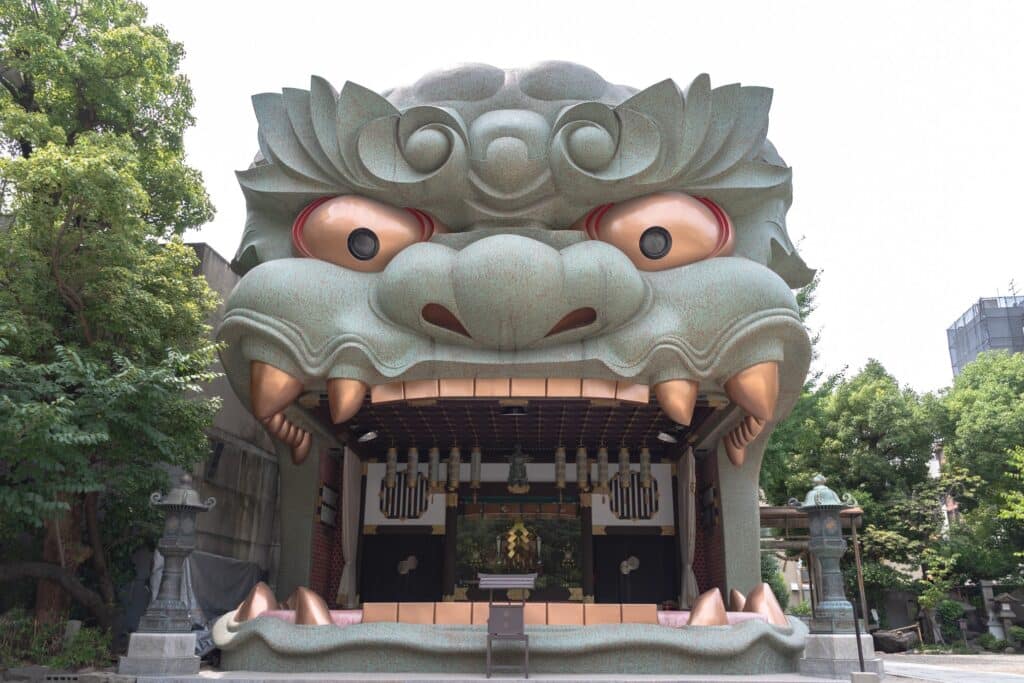
Located 15 minutes walk from Kuromon Ichiba Market is the Instagram-famous Namba Yasaka Jinja, a Shinto shrine known for its lion head shrine.
Although a small temple, Namba Yasaka Jinja is a nice escape from the bustling Osaka. The shrine has been restored several times after wartime fires and what you see now is a restoration after the war.
If you happen to visit Osaka in January (the third Sunday of January), you can witness the tug-of-war ritual at the shrine.
Walk Around Shinsekai District (新世界)
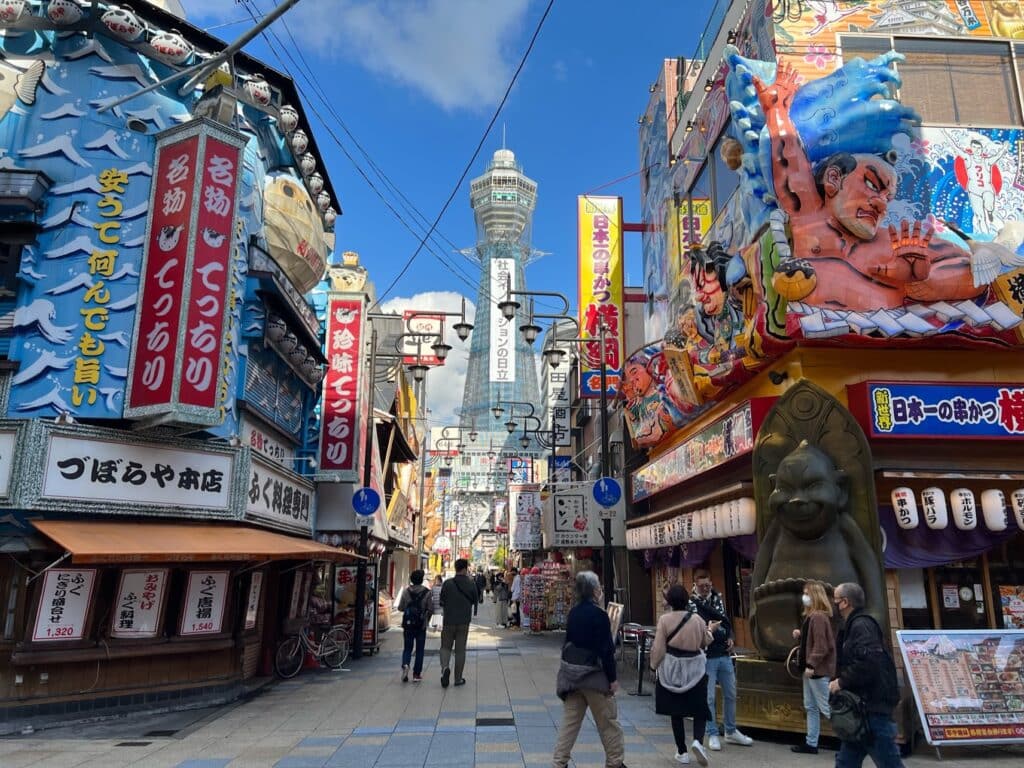
Shinsekai is an interesting neighborhood about 20 minutes walk from Namba Yasaka Jinja. Its name means “New World” and it was originally built modeling New York and Paris as an entertainment district.

Known for its big signs and its retro vibe with many old eateries and establishments, Shinsekai is a great place to explore during the day or at night, although some areas could be seedy at night. If you are looking for some snacks, then the most popular food in Shinsekai is Kushikatsu, Japanese fried skewers. You will find a ton of restaurants offering it in Shinsekai.
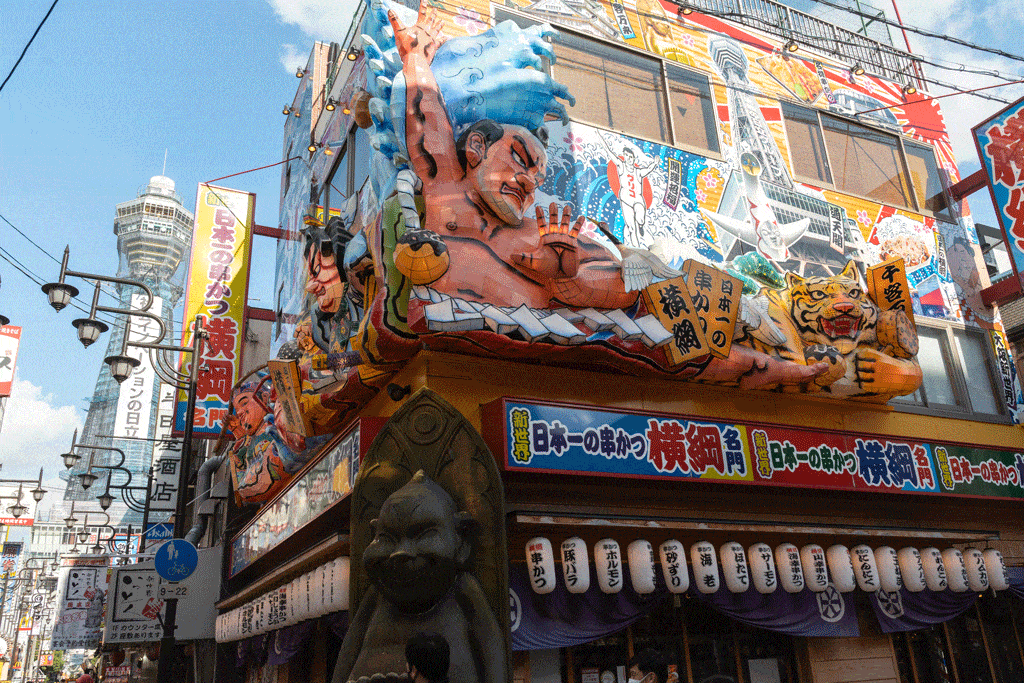
Some of the most iconic features of Shinsekai District include the view of Tsutenkaku Tower, narrow alleyways with izakayas, Spa World, a large hot spring complex, a Mega Don Quijote store that sells all sorts of things, and Shinsekai Tsutenkaku shopping street filled with shops and souvenir stores.
Walk Around Minami/ Namba Area

You will now go back north to the busy Minami/ Namba area. Some of the most noteworthy areas to check out include:
- Amerikamura: a western-influenced teen hang out area with restaurants, bar and shops
- Shinsaibashi-suji: the famous shopping street in Osaka with shops and malls
- Dotonbori: the lively district by the river known for its restaurants and eateries

It is best to visit Dotonbori at night and it is perhaps the most well known area in Osaka. You may recognize Dotonbori by the giant Glico Running Man sign along the Ebisu Bridge. The area is known for its neon lights, food stalls and restaurants.
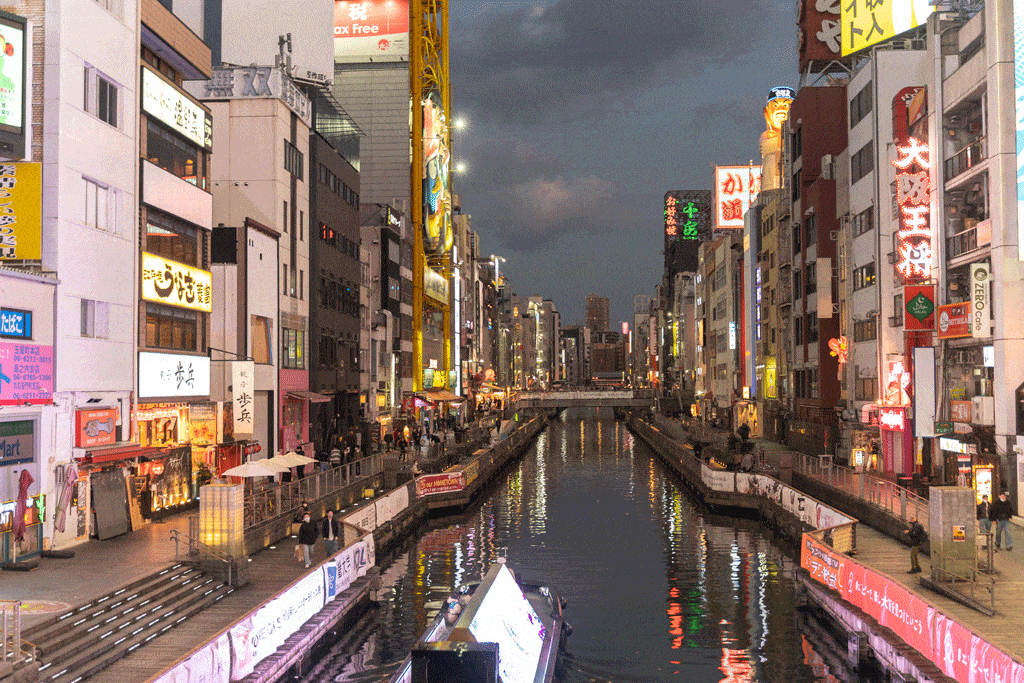
Some of the best food to eat at Dotonbori include takoyaki (octopus dough balls), crab restaurant (Kani Doraku), skewers, Andrew’s Egg tarts, candied fruit skewer, kobe beef, gyoza (at Osaka Osho) and much more.


Come to Dotonbori hungry because this is a food lover’s haven, even though it is quite touristy. Besides food, you can also do a relaxing 20 minute boat tour on the river and see the lights from the river. This boat ride is free for Osaka e-Pass and Osaka Amazing Pass holders.
Japan itinerary Day 2 : Day Trip From Osaka
On your second day of your 10 days in Japan, you have a few options in terms of what day trip you want to take from Osaka.
Himeji Castle
The most popular day trip from Osaka is to Himeji Castle (姫路城), one of the most beautiful castles in Japan and a UNESCO World Heritage Site.

Unlike Osaka Castle which has been re-built and turned into a museum, Himeji Castle is still the original castle inside. Its beautiful white exterior and historical significance makes it one of the most popular day trips from Osaka.

You need to pay for tickets to get in and there used to be free English tours offered by volunteers but since the pandemic it is not clear if they resumed the tour.
You can check out their website to contact them. Alternatively you can hire a guide so you can learn more about the castle.
Miyajima (Itsukushima) or Hiroshima

I’m sure you have seen photos of floating red torii gates in Japan. The good news is that you can visit Miyajima Island for its iconic floating torii gate from Osaka as a day trip.
Although a very long day trip, you can have the chance to explore the floating torii gate and the island as well as try some local eats. You can spend the entire day on the island or couple it with a day trip to Hiroshima in the afternoon.
You can read my detailed Osaka to Miyajima Day Trip guide for all the information.

Alternatively you can always do a day trip to Hiroshima without going to Miyajima Island as many people say Hiroshima is one of their favorite cities in Japan!
Universal Studios/ Nintendo World from Osaka
A very popular day trip idea near Osaka is to spend the day at Universal Studios and check out Nintendo World.
Only in 2023 did Nintendo World open up in Los Angeles. If you are not going to California then the best option to check out this unique area of the park is to do it in Osaka.
If you do plan on spending the day at USJ, then I would recommend getting the Express Pass. Even on a weekday lines for rides can be anywhere from 1-3 hours, without the Express Pass you will basically spend most of the day stuck waiting in line and not doing many rides.
After your day trip, hop onto the train to Kyoto at night. The train from Osaka to Kyoto takes between 20 minutes to 1 hour depending on which train you take.
Day 3 of 10 Days in Japan: Explore Kyoto
During your 3rd day in Japan (and first day in Kyoto), you will visit the famous Fushimi Inari and explore the markets and some temples of Kyoto.
To get around Kyoto and see the temples it is best that you utilize the public bus system. You can use your IC cards to ride the bus (or you can pay coins or buy a day-pass). Kyoto’s metro system is not as comprehensive as Tokyo so local buses (with Google Maps or the other travel apps I mentioned above) are the best way to go.
Things to do in Kyoto
- Admire the torii gates at Fushimi Inari
- Check out Nishiki Market for Lunch
- Temple hopping in Northern Higashiyama
- Walk the Philosopher’s Path
- Explore Gion & Pontocho at night
- Take photos of the iconic Yasaka Pagoda
- Visit the georgeous Kiyomizu-Dera
- Explore the streets of Southern Higashiyama
- See the Beautiful Kinkajuki (Golden Pavilion)
Where to Stay in Kyoto
There are different areas you can stay in Kyoto based on your budget and plans.
If you want to be close to the photo spots so you can take those IG photos without people early in the morning, then I suggest you stay in South Higashiyama. If budget is no concern then consider Park Hyatt, otherwise consider Hotel Seiryu.
If you want to go out at night and be close to Gion then consider staying near Kamo River. We stayed at Cross Hotel Kyoto on our most recent trip.
If you don’t mind being a bit further away but at a more unique hotel, then consider Hotel Kanra Kyoto. We stayed there the first time we went to Kyoto and I LOVED it with its wooden bath tub and traditional Japanese decor.
Morning: Fushimi Inari (伏見稲荷大社)

Dedicated to the Shinto god of Inari, Fushimi Inari is perhaps one of the most famous shrines in Japan known for its thousands of red torii gates. It has more than 1000 years of history and it’s one of the most important shrines in the region.

At Fushini Inari, you will find inscriptions on the other side of the torii gates. These torii gates are actually donations from individuals and companies, so the donors’ names (mostly companies) are inscribed onto the torii gates.
Most people stop exploring after a climbing the torii gates for 15-20 minutes, but you can actually climb all the way up to the top, giving you a view of Kyoto. You will also see less and less people the higher you go.
Fushimi Inari is not too far from Kyoto, only about a 10 minutes train ride on the Nara Line. Since Fushimi Inari is super popular, you should aim to visit by 7:30am at the latest to avoid the crowds.
After visiting Fushimi Inari, you will come back to explore Kyoto.
Lunch: Nishiki Market (錦市場)
After Fushimi Inari, come back to Kyoto to visit the renowned Nishiki Market, a 400 year old food market that spans a total of 5 blocks.
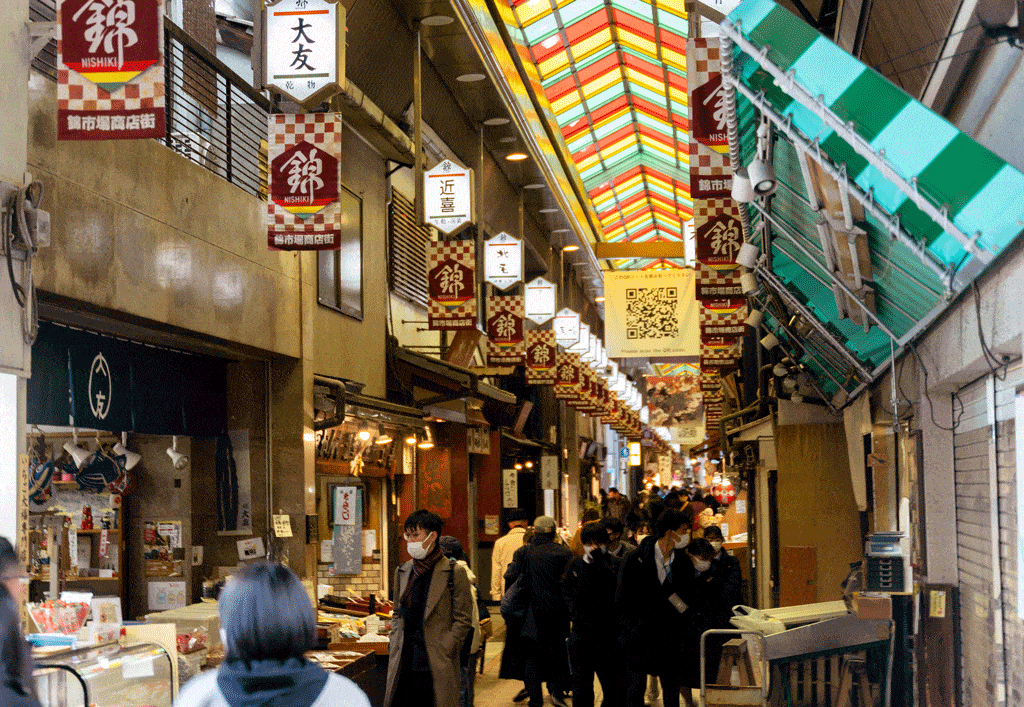
Similar to Kuromon Ichiba Market in Osaka, Nishiki Market is a covered food and produce market with over 100 vendors. It is a popular market among tourists and locals alike.

You will find some Kyoto specialities at Nishiki Market and some of the best foods to eat at Nishiki Market include yuba (tofu skin) and yuba krokke (croquette), tempura, senbei (rice crackers), mochi, fish cakes, soy milk donuts, fu manju (gluten bun), potato tempura and fishcake, sea bream skewer, and hamo (pike eel) tempura.

Stores are typically open from 10am to 6pm but many stalls are closed on Wednesday or Sunday. Therefore it’s best to come around lunch time since if you go right when they open, some of the stalls may actually be still closed.
Afternoon: Temple Hopping in Northern Higashiyama
There is no shortage of temples in Kyoto and the Higashiyama Ward is known for its shrines, historical buildings and temples.
Since there are so many temples, I will break up the Higashiyama ward into two parts: north and south.
During your first day in Kyoto, you will be covering the most important shrines in north Higashiyama (and as you guessed it, we will focus on south Higashiyama tomorrow).



Some of the most famous temples in Northern Higashiyama include:
- Nanzen-ji Temple
- Eikan-do (Zenrin-ji) temple
- Honen-In Temple
- Ginkakuji the “Silver” Pavilion
- Philosopher’s Path connecting Nanzen-ji to Ginkakuji
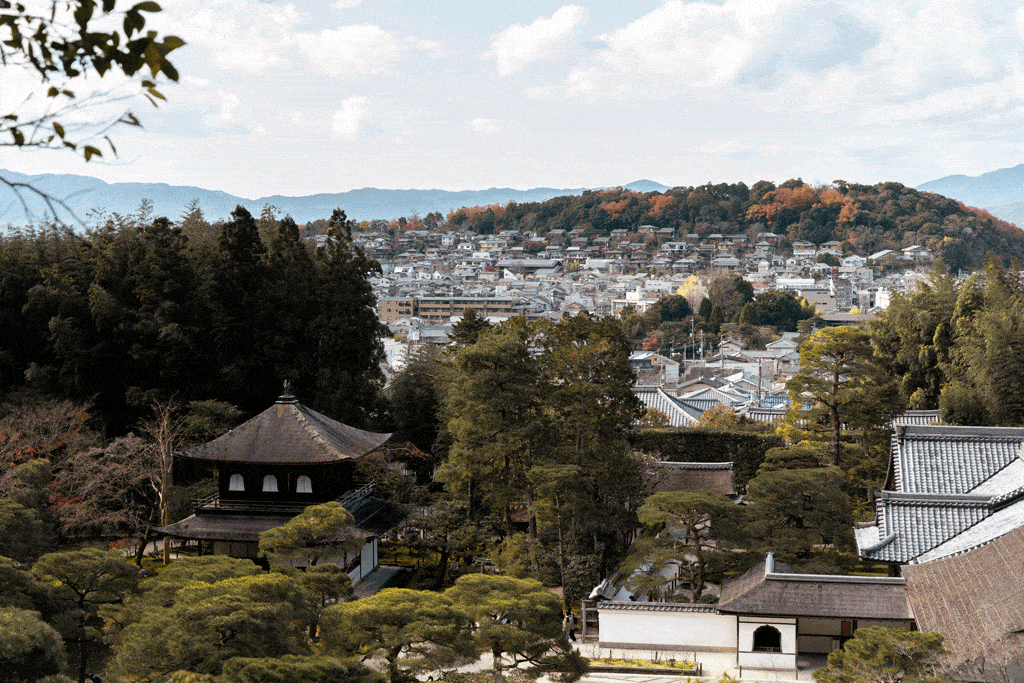
If you have the energy and time, I definitely recommend walking at least part of the Philosopher’s Path to visit all the temples mentioned above.
The first time I walked this was right after cherry blossom season and it was beautiful. As you can imagine during peak cherry blossom season the path would be extremely beautiful but also very crowded.

For the Kyoto temples mentioned above, you generally need to have a ticket to enter although they are not very expensive and most temples close at 5pm so allocate your time accordingly!
Night: Explore Gion & Pontocho
Gion is known for its association with Geisha (traditional Japanese female entertainers) and it is one of the last remaining Geisha districts in Japan.
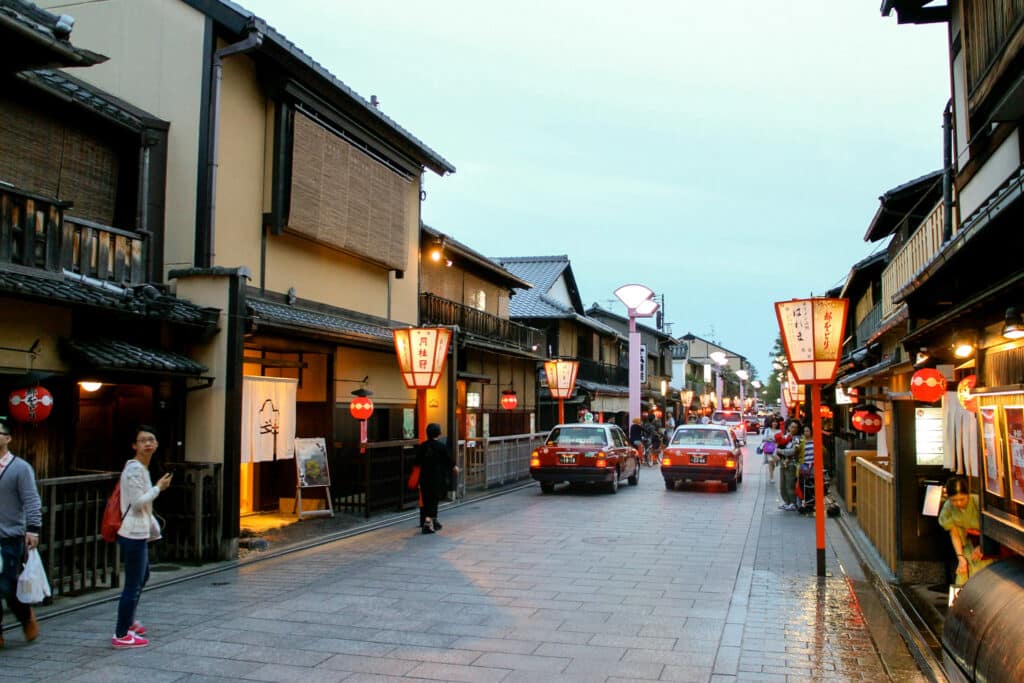
Gion is beautiful to visit especially at night and you will find a lot of private tea houses and restaurants in Gion. If you are lucky enough, you can see a geisha in Gion (I’ve never seen one unfortunately).
The best way to explore Gion is to walk around and check out the traditional houses, high end shopping and restaurants on some of the most famous streets in Gion, such as Hanami Lane and Shijo Dori.
Note that in 2024, Kyoto is banning tourists from some private alleys in Gion due to harassments of Geishas by tourists. You also cannot photograph Geishas. Please be respectful when visiting Kyoto and follow rules.
After exploring Gion, be sure to cross the Shijo Bridge (Shijo Obashi) to the west then go north to Pontocho, one of the most beautiful and cool streets in Kyoto.

Pontocho is a pedestrian only narrow street and you will find it lined with traditional restaurants, bars and shops. If you didn’t get a chance to eat in Gion then you should definitely find a place to eat in Pontocho Alley.
Day 4 in Japan: See More of Kyoto
During your second full day in Kyoto you will explore south Higashiyama to visit some of the most famous shrines in Kyoto as well as Kinkakuji, the golden shrine Kyoto is famous for.
Explore South Higashiyama
In fact you’ve already been to south Higashiyama the night before! Gion is technically located in South Higashiyama.
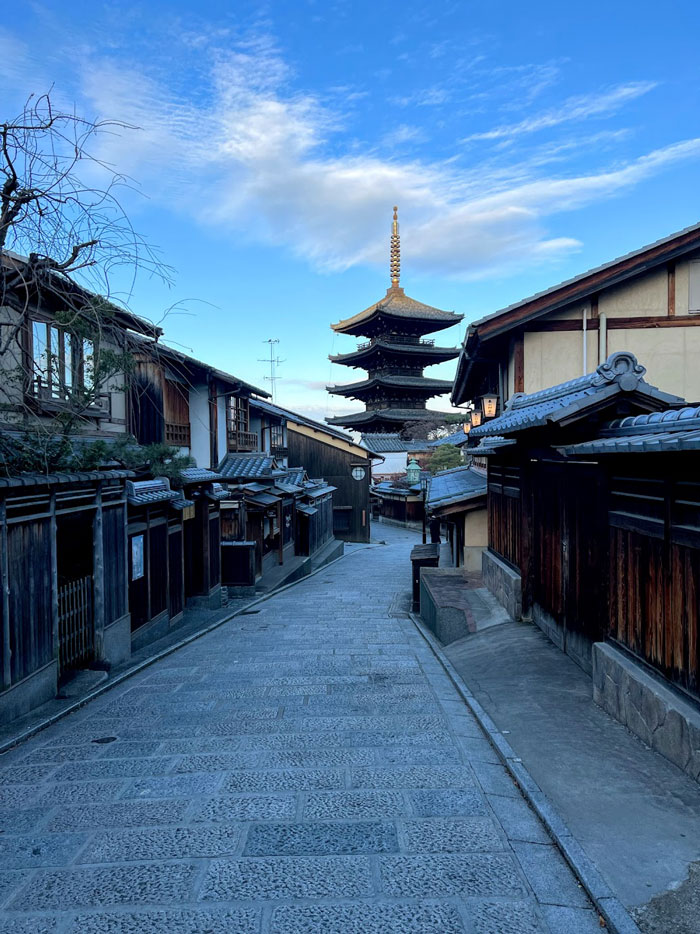
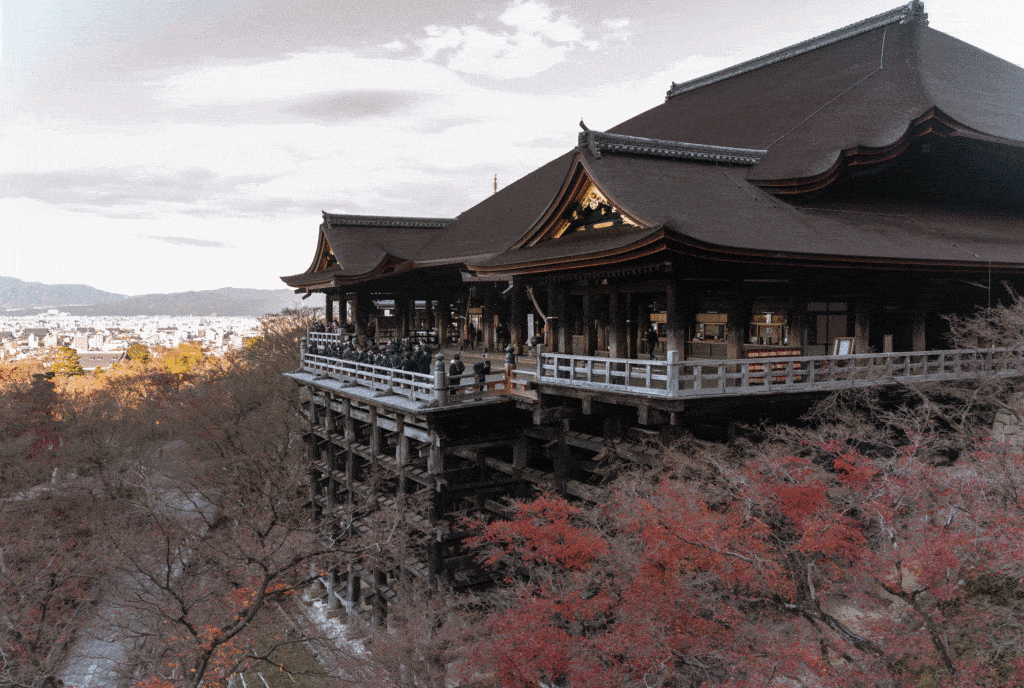
Some of the best places to visit in South Higashiyama include:
- Yasaka Pagoda photo (arrive by 7am): the most instagrammable alley in Kyoto
- Kiyomizu-dera (arrive by 8am): the iconic Buddhist temple and UNESCO World Heritage Site
- Sannenzaka and Ninenzaka: shopping areas in Kyoto with stores and cafes opening at 9am
- Isibekouji: the most atmospheric stone-paved pedestrian alleyway in Kyoto with traditional Japanese architectures (no photos allowed)
- Kodai-ji Temple: a temple complex with a beautiful Japanese garden (incl. rock garden), a tea house and bamboo grove. They also have evening illuminations.


After exploring South Higashiyama, take a break to grab some lunch and maybe dessert before heading to the Golden Pavilion, Kinkakuji.
Afternoon: See the Beautiful Kinkajuki (金閣寺)
Kinkakuji is one of the most famous Buddhist temples in Kyoto and it is also a UNESCO World Heritage Site. Kinkakuji is gold in color on its 2 top floors and this unique appearance attracts tourists across the world.

Kinkakuji is not located in South Higashiyama so you will need to take a local bus to get there.
After getting back to Kyoto you can walk around a little more before grabbing dinner. I highly recommend you try one of the Kaiseki restaurants in Kyoto. I have tried both Kikunoi Roan and Nishikawa and both were quite delicious.
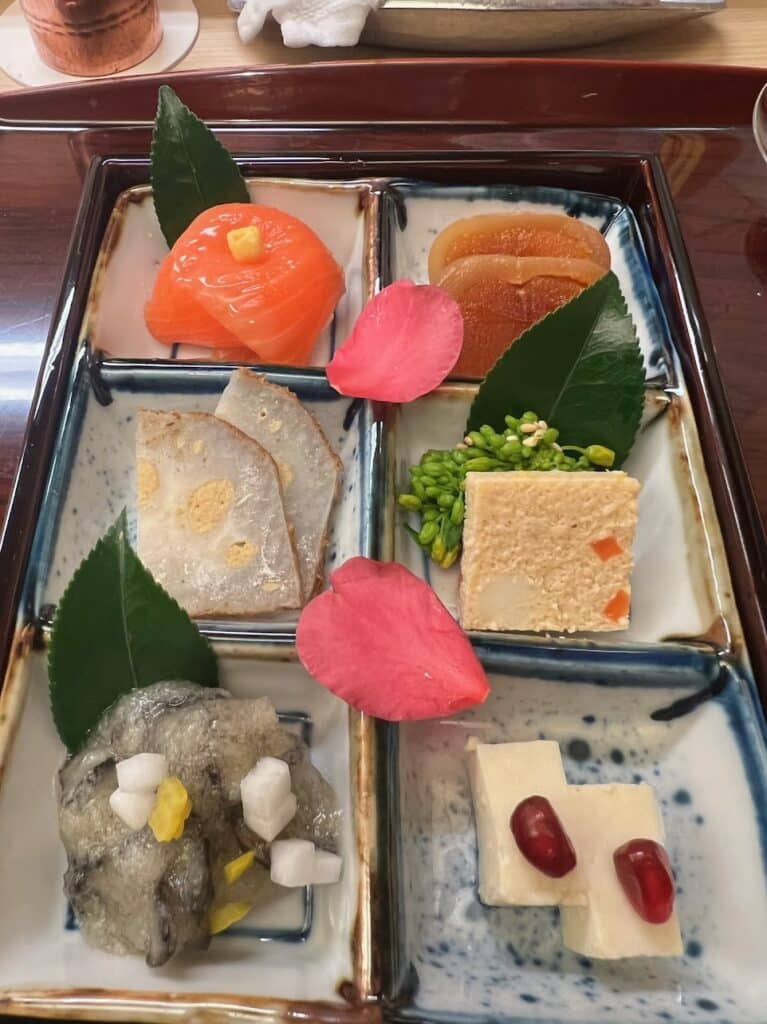
Read Next: Essential 2 Day Kyoto itinerary
Japan Itinerary Day 5: Day Trip From Kyoto to Arashiyama or Nara
It’s another day trip time! And now you are faced with a dilemma on which day trip you want to take from Kyoto.
Arashiyama Day Trip From Kyoto
The two most popular day trips from Kyoto include the bamboo grove of Arashiyama and Nara.
If you want to visit the renowned bamboo forest near Kyoto, you will head over to Arashiyama early in the morning (by 7:30am to photograph the bamboo grove without people).

Aside from the bamboo grove, Arashiyama has a number of temples, Japanese gardens and a monkey park you can visit. You can also take a tourist train through the Arashiyama mountains to see the beauty of the area. There are also some really interesting tofu restaurants that are Arashiyama is known for.
Check out my detailed blog on what to do and eat in Arashiyama.
Nara is also a popular day trip option from Kyoto
Nara is a historical city located about an hour by train south of Kyoto. It is known for its temples, shrines and wild deer in Nara Park.

If you are doing a day trip to Nara from Kyoto you probably will spend the entire day in Nara Park and check out the famous temples like Todai-ji and Kofuku-ji.
Nara Park is also famous for its friendly deer population. It’s actually why I went to Nara Park during one of my visits to Japan.
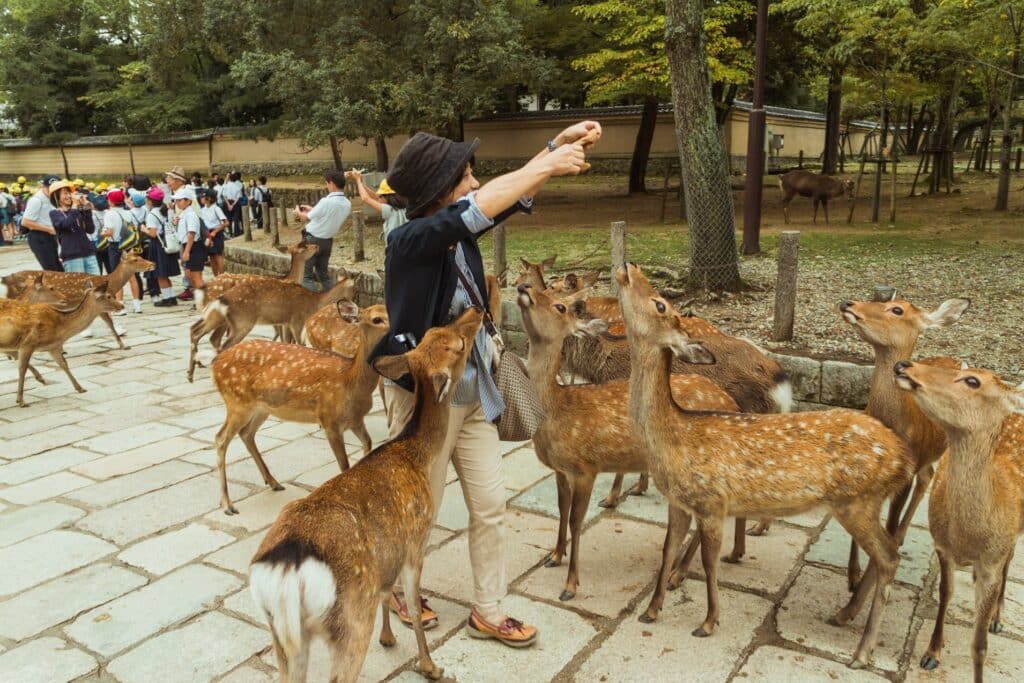
The park itself is huge and there are hiking trails in the park. I hiked to the summit of Mt. Wakakusa on a pretty easy and family friendly trail when I went to Nara.

If you want the best of day trips from Kyoto, consider this bus tour! This tour takes you to Nara, Arashiyama bamboo grove and even some places in Kyoto that you may or may not have time to get to during the two previous days!
Day 6 in Japan: Travel to Tokyo and Explore Shinjuku in Tokyo
After your eventful few days in and near Kyoto, it is time to travel to your final city in Japan: Tokyo. You will be traveling by the Shinkansen bullet train to Tokyo. If you are wondering how many days in Tokyo you need, be sure to read my complete Tokyo itinerary.

If you bought those JR Pass it’s time to use that and get your money’s worth. It takes about 3 hours on the bullet train so you should be in Tokyo around noon.
Tokyo is honestly one of my favorite cities in the world. It is so busy yet so organized and clean. It is a mixture of traditional Japanese architecture and modern western atmosphere. You will find both the old and new in Tokyo.
Most importantly Tokyo has EVERYTHING. There are amazing restaurants, great bars, cute cafes, dazzling stores, super hero street Go Kart, and much much more. It is also a great base to do some day trips (like to Mt. Fuji area).
I hope you are shipping your luggage from Kyoto to Tokyo so you don’t have to worry about dragging your stuff around and checking into your hotel. Time is of the essence when you only have 10 days in Japan!

Where to stay in Tokyo
Tokyo is a large city with many good areas to stay. But for me personally, I always stay in Shinjuku because that train station has so many train lines and buses. You need to take the metro to get around Tokyo anyway so you want to stay near a transportation hub.
In Shinjuku I’ve stayed at Hyatt Regency, Keio Plaza Hotel, and Hotel Century Southern Tower.
If you want the best view of Tokyo Tower, you should stay at Tokyo Prince Hotel, Prince Park Tower, the Tokyo EDITION or the new Janu Tokyo.
If you want to stay at unique places in Tokyo, check out Book and Bed Tokyo (a hostel), Artist Hotel, Henn na Hotel (only robots, no humans), or this Godzilla Themed hotel.

Saving Money on Tokyo Attractions
Tokyo has some really famous attractions like teamLabs, Shibuya Sky, City View, SkyTree, etc. You can save a lot of money on these attractions (and even Tokyo Disneyland) with this Tokyo attraction pass.
You will be spending the rest of your day in Shinjuku, one of the most lively areas in Tokyo.
To be honest Shinjuku is best enjoyed just by walking around during the day and at night. There are large department stores and camera stores. If you are coming from North America you probably have never seen this type of liveliness (even I don’t think New York City can compare).
If you want some peace and tranquility, stop by the Shinjuku Gyoen National Garden during the day. Featured in the animated film The Garden of Words, Shinjuku Gyoen National Park is one of the nicest parks in Tokyo.
It was designed by a French landscaping designer and features a few different gardens like the French Garden, English Garden and a traditional Japanese Garden. This garden is a nice escape from the hustling and bustling of the big city.

There are many observation decks in Tokyo but if you are looking for a free one, then be sure to go up Tokyo Metropolitan Government Building to get a nice view of the city.
On your first night in Tokyo, you should get food and drinks in Shinjuku. You will find karaoke bars, restaurants, Pachinko, hostess bars, nightclubs and much more.

The best places to explore in Shinjuku at night include:
- Kabukicho (red light district)
- Ryu no Miyako Inshokugai (new food court, cool atmosphere but bad food)
- Omoide Yokocho (alleyway with izakayas)
- Golden Gai (small area with over 200 tiny bars)
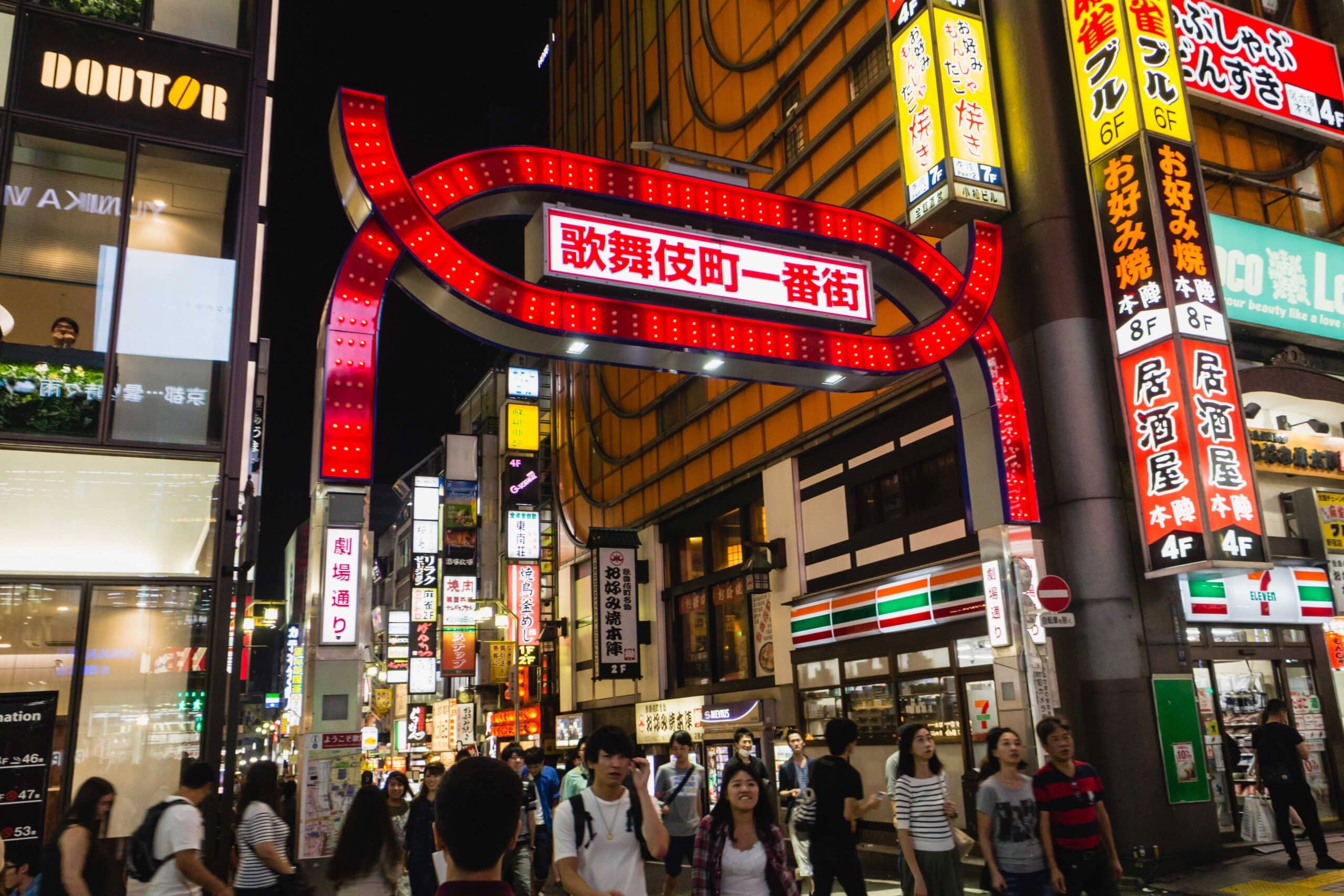
Or you can go to the New York Bar (featured in the movie Lost in Translation) at Park Hyatt in Shinjuku.
You can always do a food tour in Golden Gai or a night foodie tour in Shinjuku if you don’t know where to go eat and drink. These tours are usually led by a local showing you a few famous places to eat and drink since you might not be able to go to the really local places without knowing Japanese.
Japan itinerary Day 7: Tokyo (Tsukiji, Ginza, Harajuku, Shibuya)
On your second day in Tokyo you are gonna hit a lot of famous spots and neighborhoods. I hope you are well rested because you’ll be out all day again.
Start your morning at Tsukiji Outer Market, the famous fish market that you probably heard so much about.
Tsukiji Outer Market (avoid Wednesday and Sundays)
Actually in 2018 Tsukiji “inner market” moved to Toyosu Market. The inner market is where the famous tuna auction took place. What is left in the original location is the “outer market” of Tsukiji.

The Tsukiji Outer Market is essentially a food market, with over 400 shops and restaurants. You can still buy raw seafood (in smaller packages) or you can get sushi and other food The best things to get from Tsukiji Outer Market include:
- Oysters
- Scallops
- Skewers
- Tamagoyaki (grilled egg cake)
- Strawberry mochi
- Wagyu beef
- Origiri (rice balls)
- Matcha ice cream
- Menchi katsu (ground meat cutlet)
- Sea urchin bun and many more

If you are overwhelmed by all the choices you can do this food and drinking tour in Tsukiji to try the best places. This tour tells you the history of Tsukiji Market and takes you to some really local spots that you may not have found by yourself.
Go early in the morning as Tsukiji Outer Market closes around 2pm. It is also closed Wednesday and Sunday.
Explore Ginza
Ginza is an upscale and expensive neighborhood known for its luxury boutiques, restaurants, and fancy hotels. It is only about a 10 minute walk from Tsukiji Outer Market.

Some of the best places to check out in Ginza is the LV Cafe (Le Cafe V), designer boutiques and luxury mall such as GINZA SIX, Kabuki-za theater, flagship UNIQLO Store (the largest in the world), Art Aquarium Musuem, and Hayao Miyazaki’s NTV Clock if you are a Miyazaki fan.
Art Aquarium Museum is included in this Tokyo attraction pass.

Visit Meiji Temple
Located in Shibuya, Meiji Temple is one of the most important Shinto shrines in Japan. It was built in 1920 to honor Emperor Meiji and Empress Shoken after their death a few years prior.


The temple is located in a serene forest with the main hall and several other buildings.
At the shrine you can buy different kinds of amulets for different types of wishes. You can also purchase Ema (votive tablets), write your wishes on it and hang it around the tree in front of the main shrine.
You may also witness a traditional Japanese wedding ceremony at the shrine when you are there.
Check Out Cutesy Fashion in Harajuku
Not far from Meiji Temple is Harajuku, a district known for its young fashion culture as well as designer stores. The two most famous streets in Harajuku are Omotesando (labeled as the Champs-Elysees of Tokyo) and Takeshita Dori, the heart of Harajuku.

It’s always fun to walk around Harajuku to see the teenage fashion and get those colorful cotton candies or delicious crepes. Or you can go take the instagram photo at the mirrored kaleidoscope at Tokyu Plaza.
If you are a vintage Chanel fan, be sure to check out AMORE Vintage Omotesando but expect to wait in line to get in.
Absorb the Energy in Shibuya
Next hop over to Shibuya, one of the most well known areas in Tokyo. Even if you don’t know Shibuya by name, you are probably familiar with its pedestrian crossing, featured in the movie Fast and the Furious: Tokyo Drift.

You can simply walk across Shibuya Crossing, or you can sit in the Starbucks right next to it and people watch. I have even driven a Go Kart while dressed up in a costume across Shibuya Crossing, not once, but twice!
Again, walk around Shibuya to check out the pedestrian streets, cafes, malls and stores.

Some of the most noteworthy stores you can check out in Shibuya include:
- Parco: large shopping center
- Shibuya 109: one of the most well known shopping mall in Shibuya, catered to females
- Loft: super cool and unique stationery store
- Tokyu Hands: arts and crafts and other household items. They have all sorts of things
- MEGA Don Quijote: Sells pretty much everything from souvenirs to food/snacks to gadgets to beauty products to houseware to other quirky Japanese things
- Pokemon Center if you are a fan! But expect super long line
Of course let’s not forget about food. If you want to sample the best Japanese food and drinks in the area, you can also do this Shibuya bar hopping night tour.

Lastly, if you are in Shibuya, you must check out Shibuya Sky, the newest and most trendy observation deck in Tokyo. This is where all the instagrammer go to take videos of the moving escalator against a Tokyo sunset.
You should definitely reserve tickets ahead of time since they do get sold out, especially for sunset time. You will 99% not be able to get a day of tickets for sunset time.
In addition, Shibuya Sky is included in this Tokyo attraction pass.
Day 8 in Japan: Tokyo (Asakusa, Ueno, Akihabara, Roppongi)
On your third day in Tokyo you will explore a few more famous districts in Tokyo.
You may have noticed by now that there are different districts in Tokyo and most of the time you are just walking around. This is where the charm of Tokyo is at.
You are not really in Tokyo to see that many tourist attractions, because everything can be a tourist attraction. You just explore different areas of Tokyo, eat to your heart’s content and shop till you drop.
Morning: Explore Asakusa
Asakusa is a historical and culturally rich district in north east of Tokyo.

The vibe of Asakusa is completely different from Shibuya and Shinjuku. In Asakusa you will find historical temples, shopping streets, a cultural center, Asakusa Hanayashiki amusement park, and river cruises.

The best way to see Asakusa is to walk through Kaminarimo Gate (Thunder Gate) to the fun shopping street of Nakamise-dori to grab some souvenirs and street food before arriving at Senso-Ji Temple, the most famous attraction in Asakusa.

Other notable places to explore include Hoppy Street, a busy street lined with Izakaya restaurants and bars, Shin-Nakamise Shopping Street, a covered pedestrian “market” with a ton of boutiques and food vendors and Kappabashi Dougu a specialty street that sells kitchen equipments and other kitchen goods.

Check out Ueno
Make your way to Ueno, another culturally rich district in Tokyo. Most people tend to skip this area but I think it’s worth visiting.
Be sure to check out the Ueno Park (esp. during cherry blossom season), Ueno Zoo if you are traveling with kids, Tokyo National Museum if you are an art lover, Ameyoko Shopping Street and perhaps Nezu Shrine during the spring.
Explore Akihabara
Akihabara is known as the “electronic” district in Tokyo. You will find huge department stores selling all sorts of electronic products.

In Akihabara, you will also find stores with manga, anime merchandise, video games, maid cafes, arcades and the famous Japanese claw games.

If you are into Japanese anime and manga, you can probably spend hours in Akihabara. I personally loved trying out all the massage chairs in the electronic stores.
Evening: Enjoy Nightlife in Roppongi
Roppongi is a popular nightlife and entertainment area in Tokyo. It is also an area known to have a large number of expats.
Fun fact: the first time I went to Tokyo, we met a number of expats on the street and we ended up going to different bars and nightclubs together in Roppongi.
The famous Mori Art Museum and Roppongi Museum are both located there. Roppongi is also the home of many shopping centers as well as Tokyo City View, an observation deck offering 360 panoramic views of Tokyo. It is where most people take their photo of the Tokyo Tower from.
Tokyo City View is included in this Tokyo attraction pass.
Japan Itinerary Day 9: Day Trip From Tokyo
On this day you can either choose to stay in Tokyo and explore more (especially if you are flying out the next day) or go on a day trip (or overnight trip).
There are so many day trip options from Tokyo, such as
- Hakone
- Kamakura
- Mt. Fuji Area (Five Lake District)
- Atami (hot spring)
- Yokohama
- Hitachi Seaside Park (mid-April to early May)
- Nikko
- Ghibli Studio Museum
I’ve taken a lot of these day trips and they each offer something unique. But most people choose to go to either Hakone, Kamakura or Mt. Fuji Area.

Hakone is known for its hot springs, volcanic valley, Hakone Shrine (torii gate in the water), cruise on Lake Ashi, and view of Mt. Fuji on a clear day. You can go by yourself or with a tour. The tour takes you to some of the most visited spots in Hakone hassle free.

Kamakura is famed for its giant buddha statue, temples, shrines and its proximity to the beach. It is only about an hour from Tokyo, making it one of the closest places to visit as a day trip from Tokyo.
Read my complete day trip guide to Kamakura from Tokyo to see the best things to do and eat there.
Five Lake Area near Mt. Fuji is another popular place to go from Tokyo. Although best enjoyed overnight, you can certainly do a (pretty long) day trip there. Many people make the trip to visit Chureito Pagoda, take the ropeway, see a couple of the lakes, and see Mt. Fuji of course.

If you are interested in spending a night there and see Mt. Fuji from your hotel, check out my detailed guide on the hotel we stayed at and what we did. Alternatively, you can take a day tour to Mt. Fuji area.
Day 10 in Japan: Last Day in Tokyo
On your last day in Japan (and in Tokyo), spend the time to explore a couple of new areas or you can also go back to places you really liked to explore more.
TeamLab Planets & Odaiba
TeamLab Planets TOKYO is a popular digital art museum offering immersive exhibits that draws visitors from all over the world.

It is one of the most Instagram famous places in Tokyo, with its colorful and beautiful exhibits in various different rooms while you walk in water or on a mirror (don’t wear a short skirt when you visit).
Tickets cost 3800 Yen ($26-27 USD) and you should absolutely book online ahead of time.
If Odaiba is too far for you, you can go to teamLabs Borderless starting February 2024 near Tokyo Tower instead. Then you can go up Tokyo Tower after Borderless.
After you visit TeamLABs, be sure to walk over to the Unicorn Gundam Statue in Odaiba to take this photo. You can also explore the area but I personally don’t think it’s anything special.
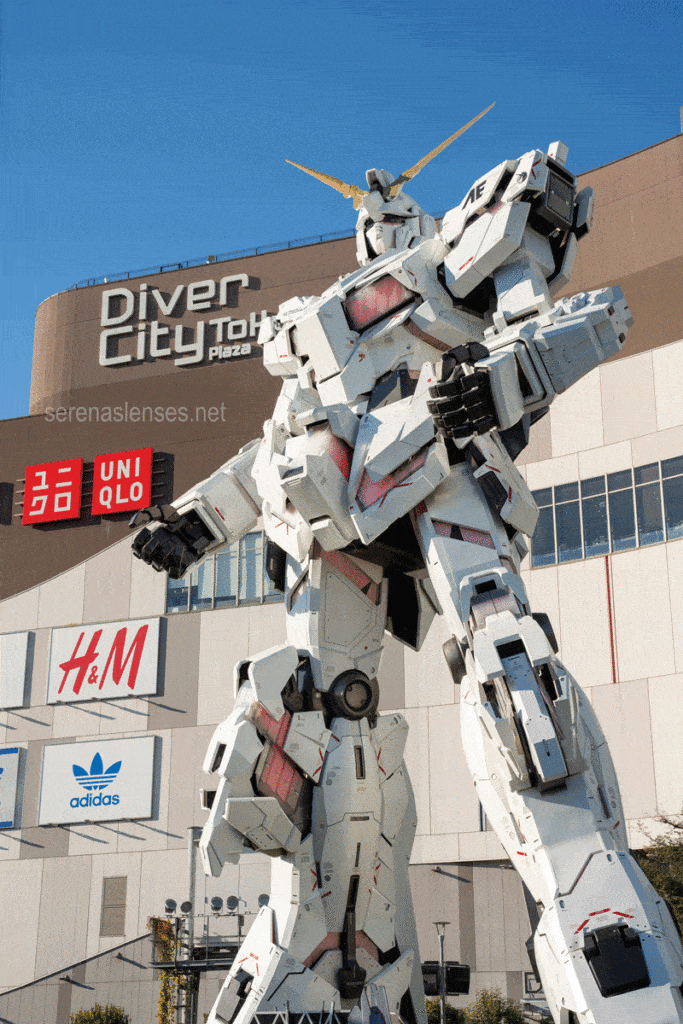
Both teamLab PLANETS and teamLab Borderless are included in this Tokyo attraction pass.
Drive a Street Go Kart in the afternoon
Street Go Kart is something unique to Japan. It originally started to mimic the famous video game Mario Kart by allowing you to dress up as a Super Mario character while driving a Go Kart on the streets of Tokyo.

But after much legal fight with Nintendo, you can no longer wear a Super Mario costume while driving it. You can now dress up as other super heroes instead.
There are tours that you can take in Tokyo to experience this unique activity and they include photoshoots like this tour or this one.
If you want to see what it’s like, read my detailed Tokyo Street Go Kart Guide.
Explore Other Parts of Tokyo
If you have some free time during this day, you should explore other parts of Tokyo based on your interest.
If you are a watch lover, you would love Nakano, especially Nakano Broadway, the best place to buy used watches in Tokyo. Tokyo has an amazing used watch market and you never have to worry about fakes.

You may have seen this cat temple in Tokyo all over Instagram and Tiktok. The temple is called Gotokuji Temple and it’s about 40 minutes from Shinjuku by train.
While you are going there, don’t forget to stop by the Shiro-Hige’s Cream Puff Factory (same metro line), and buy these viral Totoro cream puffs!
I haven’t been to these but you know they are on my list for when I go again next year (my goal is to go to Japan every year).
This will conclude your 10 amazing days in Japan. Again, if you include travel days in your 10 day Japan itinerary then you may need to skip out on some of the day trips I listed above. But you can always come back to Japan and see more, am I right?

Is 10 Days Enough For Japan?
10 days is a fantastic amount of time to get a glimpse of Japan and visit some of the most famous places in Japan.
Of course 10 days is not enough to see everything, Japan is huge after all! If you have 2 weeks in Japan you can spend more time doing day trips or overnight trips, see the snow monkey, go to the Ghibli Park near Nagoya or spend a night sleeping in a monastery near Osaka.

10 Day Trip to Japan Cost
Japan is not a cheap country, so make sure you learn about these money saving tips for visiting & traveling around Japan.
Below is a breakdown of potential cost of traveling in Japan (does not include airfare since it can vary so much depends on where you are traveling from).
- Hotels in Japan cost: minimum $100 – 150 USD a night; can be as much as $800-$1000 at luxury hotels
- Food cost in Japan: $40 – $150 a day on food, depending on what you eat (7-ELEVEN is cheap with good food)
- Transportation cost in Japan: $7 – 10 USD a day on trains and buses within a city; $100 USD on one way bullet train from Kyoto to Tokyo; $10-$20 USD a day if you do day trips (depends on distance)
- Shopping: $100 USD at least on make ups, souvenirs, cute things, etc, but obviously depends on what you are buying
Therefore on average you are looking at spending about $2000 – $3500 not including flights or much shopping during your 10 day trip to Japan.
How to Get Around Japan?
- Public transportation (subway, trains, buses) is the best way to get around Japan.
Public transportation is very efficient, always on time, extremely safe and super convenient; although subways and trains are not operating 24/7.
- If you don’t want to take public transportation in Japan (or if the trains stop running), then your next best option is to take a taxi.
The best app to call taxis in Japan is the GO/ Taxi App, followed by Didi and Uber. Uber works in Japan by calling you a taxi, it does not give you the same ride share option like in the US and Canada.
The best apps to navigate public transportation in Japan include Google Maps, Japan Transit Planner App, and Japan Travel.
How to Pay for Trains and Buses in Japan?
The easiest (and best) way to pay for public transportation in Japan is to use an IC card (either a physical card or digital format), a preloaded and rechargeable card that allows you to tap and pay for public transportation (train, metro and bus) and at convenience stores, shops and arcade games. You need an IC card per person (family cannot share one)

PASMO and Suica are the most popular IC cards in the Tokyo region; Icoca is the most popular IC cards in Osaka, Kyoto and the Kansai region. These cards all work regardless of which city you are in (you can use the PASMO card in Osaka for example).
If you follow this Japan itinerary, you will be getting an ICOCA Card when you land in Osaka.
Due to semiconductor shortage, you can only buy a Welcome Suica card at the airport and a PASMO Passport at the airport and some specific stations in Tokyo in person. However Japan is now testing out tap-to-pay system for credit cards so maybe in the future you won’t even need an IC card.

In addition, you can add an IC card to your Apple Wallet or Apple Watch. You can follow instructions on Apple’s official website. You may need to use a Master Card or AMEX Card to recharge, as VISA credit card didn’t work for Apple Pay recharge in 2023, but some people say now it’s working again in 2024.
What is the JR Pass? Do I need a Japan Rail Pass (JR Pass) for this Japan 10 day Itinerary?
JR Pass is a cost-effective option for people who plan to take multiple long-distance trips on the Shinkansen high speed train within a short period of time (7 days, 14 days or 21 days).

It is a pass that you must purchase before you land in Japan. It basically asks you to pay a fixed amount and it will cover all the trains/subways on the JR line (it does not cover trains and metros that are not owned by JR).
You should always use the JR Pass Calculator to estimate how much your planned train rides will cost to see if it’s worth buying a JR Pass given the increase in price since October 2023.
What to Eat in Japan in 10 Days
I’m sure you already know sushi comes from Japan, but there is just so much to eat in Japan (and teriyaki chicken is not one of them).
Traditional Japanese cuisines are very different from what you see in western countries. Food in Japan generally do not have strong flavors and many food is made with seasonal vegetables and root vegetables. For example you will never find a whole restaurant dedicated to Tofu in the US or UK, but it’s a thing in Arashiyama in Japan.
While you will find popular Japanese food like Sushi (but are different kinds too), ramen, tempura, gyoza in all the cities in Japan, the real beauty is in regional food in each of the cities you visit. Each city has their own speciality food that you can’t find anywhere else (many are included in this itinerary above).
The best website to look for restaurants in Japan is tabelog; anything above a 3 is good and anything above a 4 is exceptional. You will rarely find Japanese people giving 5 stars to restaurants and a 3 star is the baseline (so a 3 means the food is good and expected).
Personally I would recommend getting breakfast at a local convenience store as convenience store food is really good. Almost everyone I know gets breakfast and fried chicken and coffee from convenience store every morning.
Try to get drinks from vending machines (vending machines are awesome in Japan) and you can even get hot soup from them.
Don’t miss out on a traditional kaiseki meal; this multi-course meal is usually made with seasonal ingredients and can be more pricey. I always love the Michelin Star Kaiseki meals every time I visit Japan.
You will also find a lot of street food in Japan, especially in the markets mentioned in this Japan itinerary. Try everything! Go hungry!
Besides traditional Japanese food, you will also find a lot of western food in Japan, ranging from pizza to steak to burgers to pasta. You will always find something to eat in Japan so don’t worry.

Is Japan Safe?
Japan is one of the safest countries in the world with extremely low crime rate. It is not to say there is no crime in Japan but you don’t really have to worry about petty crimes such as pick pocketing in Japan as you do in many other countries.
You will often see elderly women on the train with their purse open because they know people will not steal their wallets. Japan is great for solo traveling because it is safe and people are extremely friendly.
I have solo traveled in Japan a few times and felt completely at ease every time. Regardless of how safe a country is, it is still best to exercise your best judgment when traveling.

What To Pack For Your 10 Days in Japan Trip
As for any International trips, you will need to pack the necessities like clothes (for the season), underwear, toiletry, medication, etc. So here I will just talk about a few other things you should absolutely bring with you to Japan:
- Deodorant: This may seem strange but Japan is not known to sell deodorant sticks in its drug stores. You should bring the ones you use, otherwise it would be very difficult to find western style deodorants.
- Apple Air Tags: This goes without saying that if you have checked in luggages you should put Apple Air tags in so you know where your luggages is in case they get lost.
- Extra bag: Japan has so much to buy even if you are not planning on shopping. On our most recent trip we bought so many Totoro and Pokemon things as well as Japanese hair dryer, hair mask, skincare products and other random things. So bring an extra duffle bag so you can shop in Japan.
- Cash or ATM Card: You need cash in Japan. The best way to get cash is through ATMs but if you don’t have an international debit card then you will need to bring cash to convert to Japanese Yen.
- Travel plug/ converter for Japan: You don’t need this if you are from the US but if you are traveling from Europe or South America then you need a travel converter.
- Compression Socks for your long flight to prevent swelling and improve circulation.
- Bag hanger: because Japanese people do not want you to leave your bag on the floor, it is considered dirty by the Japanese!
- Small hand towel: there is no hand dryer or paper towel in most Japanese bathrooms. Japanese people always bring their own so should you
- Small trash bags: you also won’t find many trash cans on the streets in Japan. Wonder how Japan is still so clean? People bring their trash home with them so you should be prepared to do that too.
- Portable Phone Battery is a must when traveling in Japan. You will be out all day so you thank yourself for bringing this.

Etiquettes in Japan
Japan has some unique etiquette and societal rules that are different from the western countries. Be sure to be aware of Japanese norms so you do not offend the locals.
- Japan train etiquette: you cannot eat or talk on the phone (or be loud) on the train.
- Shorts are not considered fashionable items in Japan! Even in the middle of the summer, most women wear long skirts and men wear long pants with short sleeve shirts. Also do not wear your Lululemon leggings. You will not see Japanese women with leggings out on the street. People won’t say anything if you do, but locals don’t do that.
- Slurping when eating noodles in Japan is considered polite, opposite from western etiquette. So slurp as loud as you can!
- When riding an escalator, stand on the left side (instead of the right) to let people pass
- Eating on the street is frowned upon. Even for street markets where you can get food, there are designated spots to stand near the store to finish your food. Do not walk and eat!
- Taking a Bath at a hot spring in Japan means you have to wash yourself first before you can get into the pool. You may also not
- Don’t be loud. Japanese people are very quiet and they follow social norms. Don’t be an annoying tourist with your loud voices please.
- Do not tip in Japan. Don’t bring your home culture to Japan, respect local customs please.
Best Japan Travel Booking Sites
If you found this Japan 10 day itinerary useful, please take a look at some of the best sites for booking hotels, tours and other activities in Japan.
Some of these sites have affiliate links where we make a small fee when you book something (at absolutely no cost to you). Thank you for your support to allow me to continue to provide high quality and useful travel information to readers like yourself.
Best hotel booking sites for Japan: Agoda or Booking <- can print out confirmation in multiple languages
Best eSim for Japan. If you are from the US and have T-mobile, you can use free international roaming and won’t need an eSim or Sim card for Japan.
Best tour booking site for Japan. I recommend booking on Klook because many times the official Japanese websites for attractions won’t take your credit card (I know because we tried).
Best food review site for Japan: anything above a 3 is good! This is way more accurate than Google Maps reviews
Best Apps to check Japan train and bus schedules and routes: Google Maps, Japan Transit Planner or Japan Travel
Best no-fee ATM card for Japan: Charles Schwab, Wise, Revolut
Best travel insurance for Japan: this or this
World Nomads provides travel insurance for travellers in over 100 countries. As an affiliate, we receive a fee when you get a quote from World Nomads using this link. We do not represent World Nomads. This is information only and not a recommendation to buy travel insurance.
Other Japan Travel Guides From Me
To help you plan your first trip to Japan, be sure to check out other resources below:
- Tokyo Mario Kart
- How many days in Tokyo: Complete Tokyo Itinerary for 2 – 7 days
- Tokyo to Kamakura Day Trip Guide
- Best Tokyo Attraction Pass to Save Money
- 2 Day Kyoto itinerary
- Best Hotel near Mt. Fuji
- One Day Osaka Itinerary
- 2 Days in Tokyo for First Time Visitors
- Arashiyama Travel Guide
- How to get to the Kyoto Bamboo Forest
- Osaka to Miyajima and Hiroshima Day Trip Guide
Like this post? Pin this Japan 10 day Itinerary to Pinterest!


